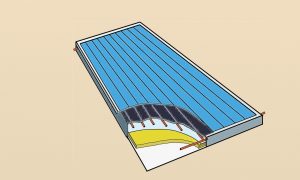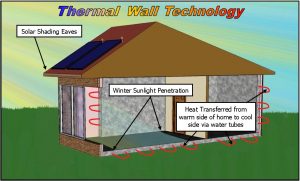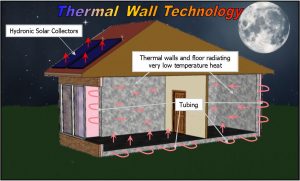Skip to content
The innovative wall design offers the optimum combination of insulation and thermal mass which together act to regulate the temperature swings of the building.
- Thermal mass is any material that can hold heat. Some materials can hold more heat (or energy) at a lower temperature. Insulation by nature cannot hold much energy but materials like metals, concrete and water can hold lots of energy.
- The Thermal Wall Technology (TWT) utilizes an exterior insulated concrete as the thermal mass. Consider Mammoth Cave in Kentucky, the cave only varies about 1-degree (53-54˚F) throughout the year. The thermal mass of the earth moderates the temperature of the cave even though the surface will vary widely. Ancient Native Americans utilized adobe and stone south-facing cliff dwellings to help moderate both the winter and summer temperatures. Now with modern insulation and the ability to transfer heat energy into the thermal mass, the thermal mass becomes a heat storage and delivery system and provides in-situ space cooling.
- The insulated thermal mass inside the building will also help moderate the interior temperature of the building, thus eliminating the heating and cooling peaks.
- Imagine living in a tent: the temperature during the day may be a comfortable 70˚F, however, at night the temperature may drop to 40˚F. The interior of the tent would quickly drop in temperature. This is not the case for the TWT building as the energy in the thermal mass of the concrete would continue to radiate heat energy to the interior of the building. In fact the thermal mass of a TWT wall is approximately 19 times that of a typical wood frame construction.
- Insulation is utilized as the primary tool to retard heat loss in cold months and heat penetration in warm months. The concept behind insulation is the creation of microscopic air pockets to create thermal bridging. The heat transfer is slowed as it must radiate energy across the tiny air pockets.
- TWT utilizes the insulation to slow the escape of thermal heat in the concrete to the exterior and then enables the thermal mass of the exposed interior concrete to help regulate the building’s interior temperature. Modeling has indicated that about 12-times as much energy is transferred to the interior than lost to the outside.
When utilized in conjunction with a hydronic solar collector heating system the TWT increases the efficiency of a solar hydronic thermal collector system by as much as 69%, seasonally.
- In a hydronic (water) solar collector system the sunlight is absorbed by an absorber plate and is converted to heat. The hot absorber plate transfers its heat to water tubes within the absorber plate and is circulated either to the walls and floors, the domestic hot water (DWH) or supplemental hot water storage to be utilized as either supplemental heating or DHW as needed.

Flat Plate Solar Hydronic Collector
- In a traditional hydronic solar collector system the hot water is transferred to a holding storage tank where it then distributes heat through an air handling system or hydronic floor heating system. Typically the minimum useful temperature of the hot water in a traditional solar hydronic heating system storage tank is in the range of 110˚F to 170˚F.
- A solar hydronic collector system can only transfer heat when the temperature of the collector is hotter than the water or thermal mass storing the heat energy. Consider a sunny day and the solar hydronic collector is 130˚F and the storage tank is also 130˚F; there is an abundance of energy from the sun but it cannot be transferred or utilized. Or consider a day of intermittent sun and clouds in which the solar hydronic collector may heat up to a 120˚F numerous times but then cools down as the clouds shade the collectors. In either event there was sunshine but no collection of energy. The thermal wall system, however, operates in a temperature range of 65˚F to 75˚F which means that anytime the solar hydronic collector temperature is above 70˚F it is collecting and storing energy. This enables the collection of the sun’s energy much earlier in the morning and continues much longer in the afternoon. This results in an approximate 69% increase in collector system efficiency as modeled using Asheville 2010 data.
When utilized in conjunction with passive solar heating the TWT increases the efficiency of the passive solar collection by as much as 75% and provides enhanced comfort over conventional passive solar collection.
- Passive solar energy passing through the windows either heats the air or objects inside the building. Ideally, the energy is absorbed by an object then re-radiates the energy to the interior of the building.
- Often in a passive solar structure the temperatures in the southern exposed rooms can vary to uncomfortable levels as the floors, objects and air heat up. To counter this either window blinds are utilized to block the sunlight or the heat is vented out of the building. In either event it represents energy not collected or energy thrown away.
- In the TWT system the floors will also have hydronic tubes which are interconnected to the thermal wall system. As the floors and walls (which should capture most of the incoming passive energy) heats up the energy can be transferred to different parts of the structure where it is needed or stored for later use. This can result in as much as 75% increase in the capture and use of passive solar energy. In addition, it provides enhanced comfort by eliminating hot and cold areas of the home or building.

Passive Solar Collection
The TWT system can also cool the building and in many regions completely eliminating the need for a conventional cooling system.
- Modeling of Asheville 2010 data indicated the thermal mass properties of the TWT eliminated all but 10-days of space cooling requirements for the cooling season.
- The substantial thermal mass that can radiate heat can absorb heat as well. In the case of heat absorption the thermal mass in the summer absorbs heat without any substantial temperature increase in the thermal walls. Energy from lights, windows, people, ventilation, appliances, etc. all contribute to heating the interior of the structure. As this heat comes in contact with the walls and floors either through direct contact or radiation, the thermal walls absorb the energy, thus cooling the structure.
- For the few days during the year in which space cooling will be required the solar collector, heat pump or a separate exhaust radiator can be operated at night to provide cool water to the thermal walls, thus cooling the interior of the structure.

Solar Collectors Providing Night Time Cooling
- The substantial surface area of the thermal mass minimizes the concern of moisture condensation; however, humidity levels will require monitoring and the percent utilization of solar cooling can vary based on climatic region.
The TWT delivers heat via infrared radiation (IR). There are numerous benefits related to efficiency, comfort and health when comparing infrared vs. traditional convection heat:
- IR heat is a more efficient heat source: Since IR heats objects not air (like a campfire) the interior air temperature can be maintained at 5-8˚F lower than convection air heating systems while maintaining the same comfort level thus creating system efficiencies. This equates to a 12-19% reduction in energy usage.
- Retention of heat by re-radiation: IR energy is either absorbed and re-radiated or reflected. Unlike the heating of air molecules in a convection system which will escape or be ejected from the building the use of infrared radiation creates an efficiency over traditional systems.
- IR does not dry out the air: Unlike other conventional convection heating systems which dry out air, IR does not (to the same extent) creating a healthier and more comfortable environment for skin, lungs and sinuses.
- IR eliminates drafts and enables better control of air exchanges: Since the energy is not being pumped into the air which constantly needs re-energizing and replacement, the precise air exchanges for health can be achieved.
- The IR eliminates the traditional forced air convection heating system and therefore requires less air movement and fewer air exchanges, creating efficiencies in energy loss and consumption: This equates to less dust, pollen and other pollutants introduced to the interior environment from the onset.
- IR dries out surfaces: This heating of surfaces helps reduce mold and mildew and other associated health concerns thus reducing costs to control mold and mildew and associated health costs.
- Constant heat comfort: IR moves at the speed of light without creating drafts thus enabling IR to deliver a comfortable level of heat with less energy.
- IR heats objects and not air: IR for the most part does not heat air it heats objects, thus the air which will escape or be ejected does not contain as much energy thus increasing the efficiency of the building.
- IR radiates in a straight line: This straight line movement of IR does not heat air and thus minimizes temperature stratification. This lowers the delta-T (temperature difference) at elevated levels in the interior and eliminates the need to operate fans in the winter which subsequently eliminates energy use, drafts, convection loops, air entraining dust, mold and other pollutants.
ICFs offer a superior strength against wind, flying debris and water surges.
- The TWT structure is much stronger than conventional wood frame construction and can more easily achieve hurricane standards. They are integrally tied to the footing or foundation slab with structural reinforcing steel. While frame walls use hurricane ties and/or anchor bolts to meet code minimums, ICF wall-footing connections are stronger by a factor of ten. Sometimes the walls are poured monolithically with the footing eliminating even the cold joint. For more information see the article in the ICF BUILDER MAGAZINE, Standing Up to the Storm: ICFs are a Perfect Fit for Hurricane-Resistant Housing.
Back to Questions Page




